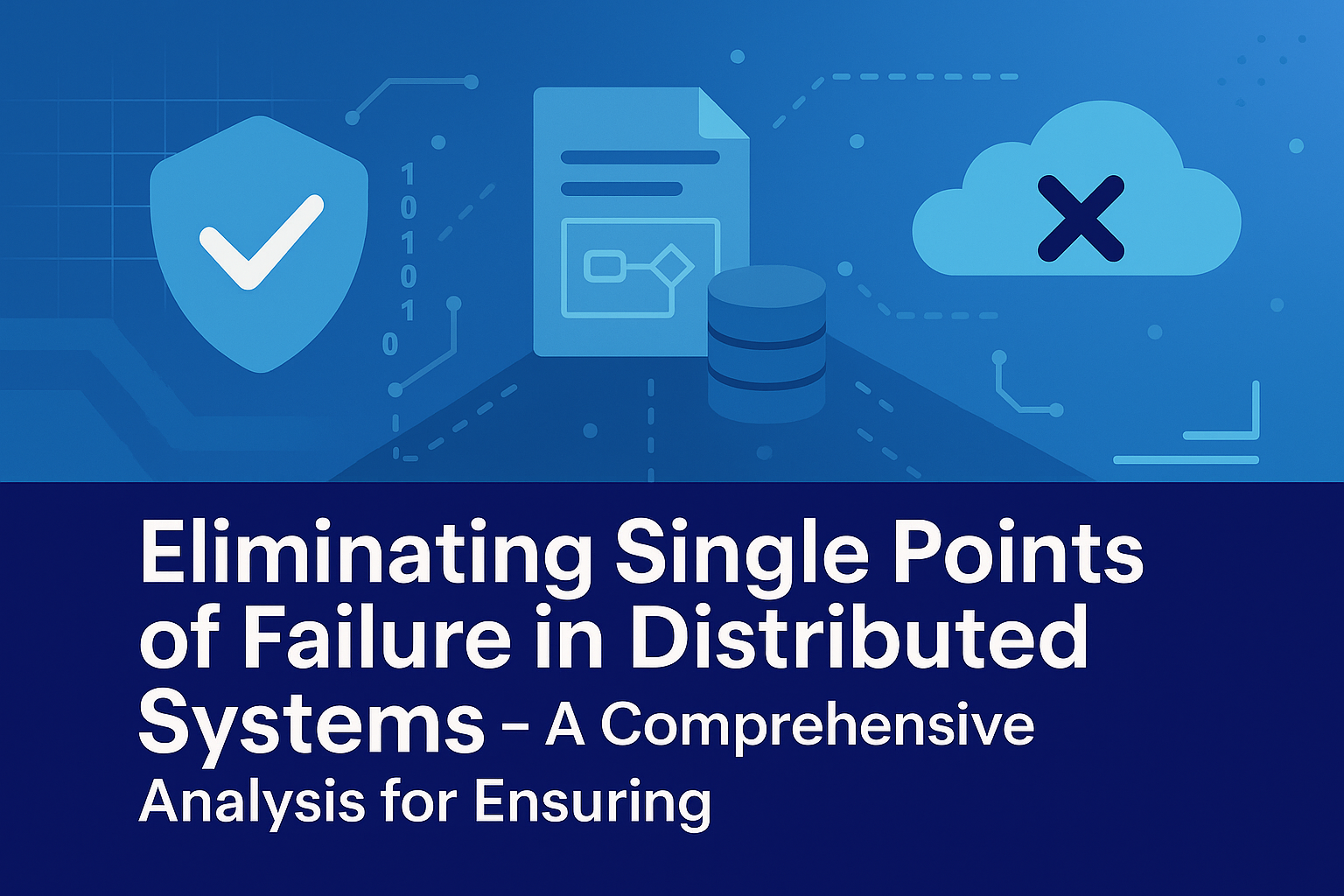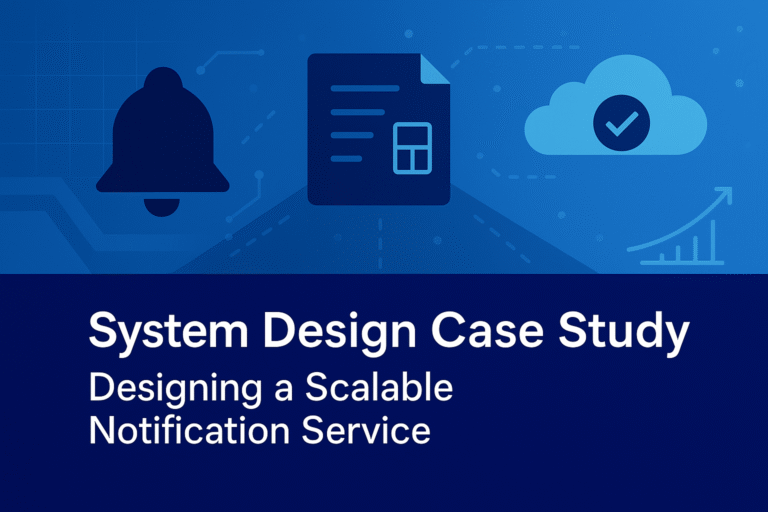Introduction
A single point of failure (SPOF) refers to any component in a system—such as a node, service, network link, or database—whose failure can cause the entire system to become unavailable or degrade significantly. In distributed systems, where scalability, reliability, and high availability are paramount (e.g., 99.99% uptime for e-commerce platforms like Amazon or ride-sharing services like Uber), avoiding SPOFs is essential to prevent cascading failures, data loss, or service outages. This comprehensive analysis explores techniques to eliminate SPOFs, their mechanisms, and their applications, building on prior discussions of Redis use cases (e.g., caching, session storage), caching strategies (e.g., Cache-Aside, Write-Back), eviction policies (e.g., LRU, LFU), Bloom Filters, latency reduction, CDN caching, CAP Theorem, strong vs. eventual consistency, consistent hashing, idempotency, and unique ID generation (UUID, Snowflake). It includes mathematical foundations, real-world examples, performance metrics, and implementation considerations for system design professionals to architect resilient distributed systems that maintain low latency (< 1ms for cache hits) and high throughput (e.g., 2M req/s), ensuring operational continuity even under adverse conditions.
Understanding Single Points of Failure
Definition and Types
A SPOF is any element whose malfunction disrupts the system. Types include:
- Hardware SPOF: Single server or disk failure (e.g., Redis node crash causing data loss without replication).
- Network SPOF: Single router or link failure (e.g., network partition in Cassandra cluster, triggering CAP trade-offs).
- Software SPOF: Centralized service failure (e.g., single Redis instance for caching, causing 100% hit rate drop).
- Data SPOF: Single database replica (e.g., DynamoDB without Global Tables, leading to 100ms latency during outages).
- Human/Process SPOF: Manual processes or single points in deployment pipelines.
Impact of SPOFs
- Downtime: Reduces availability (e.g., from 99.99% to 99%, adding 43 minutes/month downtime).
- Latency Increase: Failures cause delays (e.g., 10–50ms for rerouting, 100ms for partitions).
- Throughput Reduction: Loss of a node reduces capacity (e.g., 33% drop in a 3-node cluster).
- Data Loss/Inconsistency: Without redundancy, failures risk permanent loss or staleness (e.g., 10–100ms lag in eventual consistency).
- Financial Cost: Downtime costs $5,600/minute for enterprises (e.g., Amazon loses $66K/minute).
Metrics for SPOF Mitigation
- Mean Time Between Failures (MTBF): Time between failures (e.g., > 1 year for redundant systems).
- Mean Time to Recovery (MTTR): Time to restore service (e.g., < 5s for automatic failover).
- Availability: Percentage uptime (e.g., 99.99% = < 52 minutes/year downtime).
- Failure Detection Latency: Time to detect failure (e.g., < 3s with heartbeats).
- Data Loss Window: Time of potential data loss (e.g., < 1s with AOF everysec).
Techniques to Eliminate Single Points of Failure
1. Replication
Mechanism
Replication creates multiple copies of data or services across nodes, ensuring availability if one fails. Types include:
- Synchronous Replication: Writes block until all replicas acknowledge (strong consistency, CP).
- Asynchronous Replication: Writes complete immediately, replicas update later (eventual consistency, AP).
- Quorum-Based: Requires majority acknowledgment (e.g., 2/3 replicas).
- Implementation:
- Redis: Master-slave replication with 3 replicas (SLAVEOF master_ip).
- DynamoDB: Global Tables with async replication (< 100ms lag).
- Cassandra: NetworkTopologyStrategy with replication factor 3.
- Performance Impact: Adds < 1ms lag for async, 10–50ms for sync; increases read throughput (e.g., 3x with 3 replicas).
- Real-World Example:
- Amazon E-Commerce: Redis Cluster with 3 replicas for product caching, achieving < 5s failover, 99.99% uptime, and 90% hit rate.
- Implementation: AWS ElastiCache with allkeys-lru, monitored via CloudWatch for replication lag.
- Trade-Off: Increases storage cost (3x for 3 replicas) but reduces MTTR (< 5s).
Implementation Considerations
- Replication Factor: Set to 3 for 99.99% availability.
- Monitoring: Track lag (< 100ms) with Prometheus.
- Security: Encrypt replication traffic with TLS 1.3.
2. Load Balancing
Mechanism
Distribute traffic across multiple nodes to avoid SPOFs in any single node, using algorithms like round-robin or consistent hashing.
- Implementation:
- Redis: AWS ALB or Redis Cluster for request routing.
- DynamoDB: Internal load balancing with consistent hashing.
- Cassandra: Client-side load balancing with token-aware drivers.
- Performance Impact: Reduces queuing latency (< 1ms vs. 10ms for overloaded nodes), increases throughput (e.g., 2M req/s with 10 nodes).
- Real-World Example:
- Uber Ride Requests: AWS ALB distributes requests to Redis Cluster, achieving < 0.5ms routing latency, 1M req/s.
- Implementation: ALB with sticky sessions, monitored via CloudWatch for I/O.
- Trade-Off: Adds < 1ms network overhead but prevents hotspots.
Implementation Considerations
- Algorithm: Use consistent hashing for cache affinity.
- Monitoring: Track distribution variance (< 5%) with Grafana.
- Security: Use TLS 1.3 for balanced traffic.
3. Failover and Redundancy
Mechanism
Failover switches to redundant components (e.g., replicas) on failure, using heartbeats for detection.
- Implementation:
- Redis: Sentinel or Cluster mode for automatic failover (< 5s).
- DynamoDB: Global Tables for multi-region redundancy (< 10s recovery).
- Cassandra: Gossip protocol for detection, hinted handoffs for recovery (< 10s).
- Performance Impact: Reduces MTTR to < 5s, maintaining 99.99% uptime.
- Real-World Example:
- Netflix Streaming: Redis Cluster with Sentinel failover, achieving < 5s recovery, 99.99% uptime for 1B requests/day.
- Implementation: Resilience4j for circuit breaking, monitored via Grafana.
- Trade-Off: Increases storage cost (3x for replicas) but enhances availability.
Implementation Considerations
- Detection: Use 1s heartbeats, 3s timeout.
- Monitoring: Track failover time with Prometheus.
- Security: Secure failover traffic with TLS.
4. Sharding and Partitioning
Mechanism
Shard data across nodes to distribute load, avoiding SPOFs in any single node.
- Implementation:
- Redis: Sharding with 16,384 slots via consistent hashing.
- DynamoDB: Automatic sharding by partition key.
- Cassandra: Sharding by partition key with vnodes.
- Performance Impact: Scales to 2M req/s with 10 nodes, reducing latency by distributing load.
- Real-World Example:
- Twitter Analytics: Cassandra sharding with consistent hashing, < 10s recovery, 1M req/s.
- Implementation: 10-node cluster with NetworkTopologyStrategy, monitored via Prometheus.
- Trade-Off: Adds complexity (10–15% DevOps effort) but minimizes data movement (~10% keys).
Implementation Considerations
- Shard Key: Choose even distribution (e.g., hashed user_id).
- Monitoring: Track shard balance with Grafana.
- Security: Encrypt sharded data with AES-256.
5. Monitoring and Observability
Mechanism
Proactively detect and respond to failures with comprehensive monitoring of metrics, logs, and traces.
- Implementation:
- Metrics: Latency (< 0.5ms for Redis), hit rate (> 90%), error rate (< 0.01%).
- Logs: Slow operations in Redis SLOWLOG.
- Tracing: Jaeger for end-to-end latency in microservices.
- Redis Integration: INFO, SLOWLOG for performance.
- Performance Impact: Minimal overhead (1–5% CPU) for proactive failure mitigation.
- Real-World Example:
- Uber Ride Matching: Prometheus for latency/error metrics, Grafana dashboards, Jaeger for tracing, achieving 99.99% uptime.
- Implementation: Integrated with Redis Cluster and Cassandra, monitored for replication lag.
- Trade-Off: Adds cost (e.g., $0.01/GB/month for logs) but prevents outages.
Implementation Considerations
- Tools: Prometheus for metrics, ELK for logs, Jaeger for tracing.
- Metrics: Track P99 latency (< 50ms), error rate (< 0.01%).
- Security: Secure monitoring endpoints with TLS.
6. Idempotency
Mechanism
Idempotency ensures operations can be retried without side effects, using keys or conditional updates.
- Implementation:
- Redis: SETNX for idempotent sets, Lua scripts for atomic checks.
- DynamoDB: Conditional writes (attribute_not_exists(request_id)).
- Cassandra: Lightweight transactions (IF NOT EXISTS).
- Performance Impact: Adds < 1ms for checks, ensures 100% retry success.
- Real-World Example:
- PayPal Transactions: Idempotency keys in Redis, achieving 100% retry success, < 1ms check latency.
- Implementation: Redis Cluster with SETEX, monitored via Grafana.
- Trade-Off: Adds 5–10% overhead but prevents duplicates.
Implementation Considerations
- Keys: Use UUID or Snowflake with TTL (3600s) in Redis.
- Monitoring: Track check latency and retry rate with Prometheus.
- Security: Encrypt keys with AES-256.
7. Timeouts and Circuit Breakers
Mechanism
Timeouts cap request wait times, circuit breakers halt requests to failing services.
- Implementation:
- Timeouts: Set 100ms for Redis GET, 50ms for DynamoDB.
- Circuit Breakers: Open after 50% errors in 10s, using Resilience4j.
- Redis Integration: Client timeouts with circuit breakers.
- Performance Impact: Reduces P99 latency (< 50ms), prevents overload.
- Real-World Example:
- Netflix Streaming: Circuit breakers for Redis queries, timeouts (50ms), achieving < 50ms P99, 99.99% uptime.
- Implementation: Resilience4j with Redis Cluster, monitored via Grafana.
- Trade-Off: May reject valid requests but prevents cascading failures.
Implementation Considerations
- Threshold: Tune to 50% errors, open 10s.
- Monitoring: Track breaker state and timeout rate with Prometheus.
- Security: Secure breaker logic with TLS.
8. Retries with Backoff
Mechanism
Retry failed operations with exponential backoff (e.g., 100ms, 200ms, 400ms) and jitter.
- Implementation:
- Redis: Retry GET/SET with backoff, idempotency keys (SETEX request:uuid123 3600 {response}).
- DynamoDB: Retry GetItem with backoff, conditional writes.
- Cassandra: Retry with backoff, lightweight transactions.
- Performance Impact: Increases success rate to 99%, adds 10–50ms per retry.
- Real-World Example:
- Amazon API Requests: Exponential backoff with jitter for Redis GET, idempotency keys, achieving 99% success rate, < 50ms P99 latency.
- Implementation: Jedis client with retry logic, monitored via CloudWatch.
- Trade-Off: Reduces failures but may amplify load.
Implementation Considerations
- Backoff: Base 100ms, cap 1s, 3 retries.
- Monitoring: Track retry rate (< 1%) with Prometheus.
- Security: Rate-limit retries to prevent DDoS.
Integration with Prior Concepts
- Redis Use Cases:
- Caching: Failover for Redis Cluster caching (Amazon).
- Session Storage: Retries with idempotency for sessions (PayPal).
- Analytics: Circuit breakers for slow queries (Twitter).
- Caching Strategies:
- Cache-Aside: Retries on misses (Amazon).
- Write-Through: Idempotent writes (PayPal).
- Write-Back: Retries on async failures (Twitter).
- Eviction Policies:
- LRU/LFU: Fallbacks to database on eviction.
- TTL: Timeouts for expired keys.
- Bloom Filters: Retries on false positives.
- Latency Reduction:
- In-Memory Storage: Retries with timeouts (< 1ms).
- Pipelining: Reduces RTT for retries (90% reduction).
- CDN Caching: Fallbacks to origin on failure.
- CAP Theorem:
- AP Systems: Retries and fallbacks for availability (Redis, Cassandra).
- CP Systems: Circuit breakers to prevent inconsistencies (DynamoDB).
- Strong vs. Eventual Consistency:
- Strong Consistency: Retries with idempotency for CP systems (MongoDB).
- Eventual Consistency: Fallbacks to stale data in AP systems (Redis).
- Consistent Hashing: Rebalancing after failures detected by heartbeats.
- Idempotency: Enables safe retries in all strategies.
- Unique IDs: Use Snowflake/UUID for retry keys (e.g., request:snowflake).
Real-World Examples
- Amazon API Requests:
- Context: 10M requests/day, handling failures with retries and idempotency.
- Implementation: Exponential backoff (100ms, 200ms, 400ms), idempotency keys in Redis (SETEX request:uuid123 3600 {response}), Cache-Aside, Bloom Filters.
- Performance: 99% success rate, < 50ms P99 latency, 99.99% uptime.
- CAP Choice: AP for high availability.
- Netflix Streaming:
- Context: 1B requests/day, needing graceful degradation.
- Implementation: Fallback to stale Redis cache on DynamoDB failure, circuit breaker after 50% errors, timeouts (50ms), idempotency with Snowflake IDs.
- Performance: < 10ms fallback latency, 99.99% uptime.
- Implementation: Resilience4j with Redis Cluster, monitored via Grafana.
- Uber Ride Matching:
- Context: 1M requests/day, needing failure isolation.
- Implementation: Circuit breaker for Redis geospatial queries, fallback to DynamoDB, timeouts (50ms), idempotency with Snowflake IDs, replication (3 replicas).
- Performance: < 1ms rejection in open state, 99.99% uptime.
- Implementation: Resilience4j with Redis Cluster, monitored via Prometheus.
Comparative Analysis
| Strategy | Latency Impact | Throughput Impact | Availability Impact | Complexity | Example | Limitations |
|---|---|---|---|---|---|---|
| Retries | +10–50ms per retry | -5–10% (overhead) | + (increases success) | Medium (backoff logic) | Amazon API | Amplification risk |
| Fallbacks | +< 10ms (logic) | – (graceful degradation) | + (partial service) | Medium (alternative paths) | Netflix streaming | Stale data risk |
| Circuit Breakers | < 1ms (rejection) | – (prevents overload) | + (isolates failures) | High (threshold tuning) | Uber matching | Temporary unavailability |
| Timeouts | Caps at threshold (e.g., 100ms) | – (frees resources) | + (prevents hangs) | Low (configuration) | Twitter API | Premature failures |
| Idempotency | +< 1ms (checks) | -5–10% (storage) | + (safe retries) | Medium (key management) | PayPal transactions | Storage overhead |
| Replication | +< 1ms (lag) | – (overhead) | + (99.99% uptime) | High (sync management) | Uber ride data | Replication lag |
| Monitoring | Minimal (1–5% CPU) | Minimal | + (proactive detection) | High (tool integration) | Uber monitoring | Alert fatigue |
| Size-Based | O(log n) for eviction | – (overhead) | N/A | Medium (heap management) | Netflix media | Low hit rate |
Trade-Offs and Strategic Considerations
- Latency vs. Reliability:
- Trade-Off: Retries and fallbacks add 10–50ms but increase success rate (99%). Circuit breakers reduce latency (< 1ms rejection) but may may block valid requests temporarily.
- Decision: Use retries with backoff for transient failures, circuit breakers for cascading risks.
- Interview Strategy: Justify retries for Amazon APIs, circuit breakers for Uber.
- Availability vs. Consistency:
- Trade-Off: Replication and fallbacks enhance availability (99.99%) but may introduce staleness (10–100ms in eventual consistency). Idempotency ensures consistency in strong systems but adds overhead.
- Decision: Use replication for high availability in AP systems (Redis), idempotency for CP (DynamoDB).
- Interview Strategy: Propose replication for Netflix, idempotency for PayPal.
- Scalability vs. Complexity:
- Trade-Off: Replication and monitoring scale to 1M req/s but add 10–15% DevOps effort. Idempotency scales with Redis but requires key management.
- Decision: Use managed services (ElastiCache) for simplicity, replication for large-scale systems.
- Interview Strategy: Highlight replication for Uber, monitoring for Netflix.
- Cost vs. Performance:
- Trade-Off: Replication increases costs (3x storage for 3 replicas), but reduces latency spikes. Monitoring adds 1–5% overhead but prevents costly downtimes.
- Decision: Use 3 replicas for critical data, 2 for non-critical.
- Interview Strategy: Justify 3 replicas for PayPal, 2 for Twitter analytics.
- Detection Speed vs. Accuracy:
- Trade-Off: Shorter timeouts (e.g., 3s) detect failures faster but risk false positives (< 0.01%). Monitoring reduces false positives but adds complexity.
- Decision: Use 3s timeouts with monitoring for critical systems.
- Interview Strategy: Propose 3s timeouts for Amazon, with Prometheus monitoring.
Advanced Implementation Considerations
- Deployment:
- Use AWS ElastiCache for Redis, DynamoDB Global Tables, Cassandra on EC2, or MongoDB Atlas.
- Configure 3 replicas, consistent hashing for load distribution.
- Configuration:
- Retries: Exponential with jitter (base 100ms, cap 1s, 3 retries).
- Circuit Breakers: Threshold 50% errors in 10s, open 10s.
- Timeouts: 100ms for Redis, 50ms for DynamoDB.
- Idempotency: SETEX request:uuid123 3600 {response} in Redis.
- Replication: 3 replicas with async sync for AP, synchronous for CP.
- Monitoring: Prometheus for metrics, ELK for logs, Jaeger for tracing.
- Performance Optimization:
- Use Redis for < 0.5ms idempotency checks, 90–95% cache hit rate.
- Use pipelining for Redis batch operations (90% RTT reduction).
- Size Bloom Filters for 1% false positive rate (9.6M bits for 1M keys).
- Tune circuit breaker thresholds based on P99 metrics.
- Monitoring:
- Track MTTD (< 3s), MTTR (< 5s), retry success (99%), error rate (< 0.01%), and failover time (< 5s) with Prometheus/Grafana.
- Use SLOWLOG (Redis), CloudWatch for DynamoDB, or Cassandra metrics.
- Security:
- Encrypt data with AES-256, use TLS 1.3 with session resumption.
- Implement Redis ACLs, IAM for DynamoDB, authentication for Cassandra/MongoDB.
- Use VPC security groups for access control.
- Testing:
- Stress-test with redis-benchmark (2M req/s), Cassandra stress tool, or DynamoDB load tests.
- Validate failure handling with Chaos Monkey (e.g., node kill, network partition).
- Test Bloom Filter false positives and AOF recovery (< 1s loss).
Discussing in System Design Interviews
- Clarify Requirements:
- Ask: “What’s the target latency (< 1ms)? Failure types (node, network)? Availability (99.99%)? Workload (1M req/s)?”
- Example: Confirm 1M req/s for Amazon caching with < 3s failure detection.
- Propose Failure Handling:
- Retries: “Use exponential backoff with idempotency for Amazon API failures.”
- Fallbacks: “Use stale cache fallback for Netflix during DynamoDB failures.”
- Circuit Breakers: “Use for Uber’s Redis queries to prevent cascading failures.”
- Timeouts: “Set 100ms for Twitter’s Redis GET to cap waits.”
- Idempotency: “Use keys in Redis for PayPal transactions.”
- Replication: “Use 3 replicas in Redis for Uber ride data.”
- Monitoring: “Use Prometheus for Netflix’s latency monitoring.”
- Example: “For Amazon, implement retries with idempotency keys and circuit breakers for API requests.”
- Address Trade-Offs:
- Explain: “Retries increase success rate (99%) but add latency (10–50ms). Circuit breakers reduce overload but may may block valid requests temporarily.”
- Example: “Use circuit breakers for Uber, retries for Amazon.”
- Optimize and Monitor:
- Propose: “Tune retry backoff (100ms base), circuit breaker threshold (50% errors), and monitor MTTR (< 5s) with Prometheus.”
- Example: “Track retry rate and circuit state for PayPal’s transactions.”
- Handle Edge Cases:
- Discuss: “Mitigate permanent failures with fallbacks, handle partitions with replication, ensure idempotency for retries.”
- Example: “For Netflix, use fallbacks to stale data during DynamoDB failures.”
- Iterate Based on Feedback:
- Adapt: “If availability is critical, prioritize fallbacks and replication. If latency is key, use timeouts and circuit breakers.”
- Example: “For Twitter, add idempotency to Write-Back for reliable analytics.”
Conclusion
Handling failures in distributed systems is fundamental to achieving high reliability and performance. Techniques like retries (99% success rate), fallbacks (graceful degradation), circuit breakers (failure isolation), timeouts (capped waits), idempotency (100% retry success), replication (99.99% uptime), and monitoring (proactive detection) address node, network, and partial failures. Integration with Redis caching, Bloom Filters, CAP Theorem, and consistent hashing enhances resilience, while trade-offs like latency, availability, and complexity guide design choices. By aligning with application requirements, architects can build robust systems for high-scale applications like Amazon, Netflix, and Uber.




